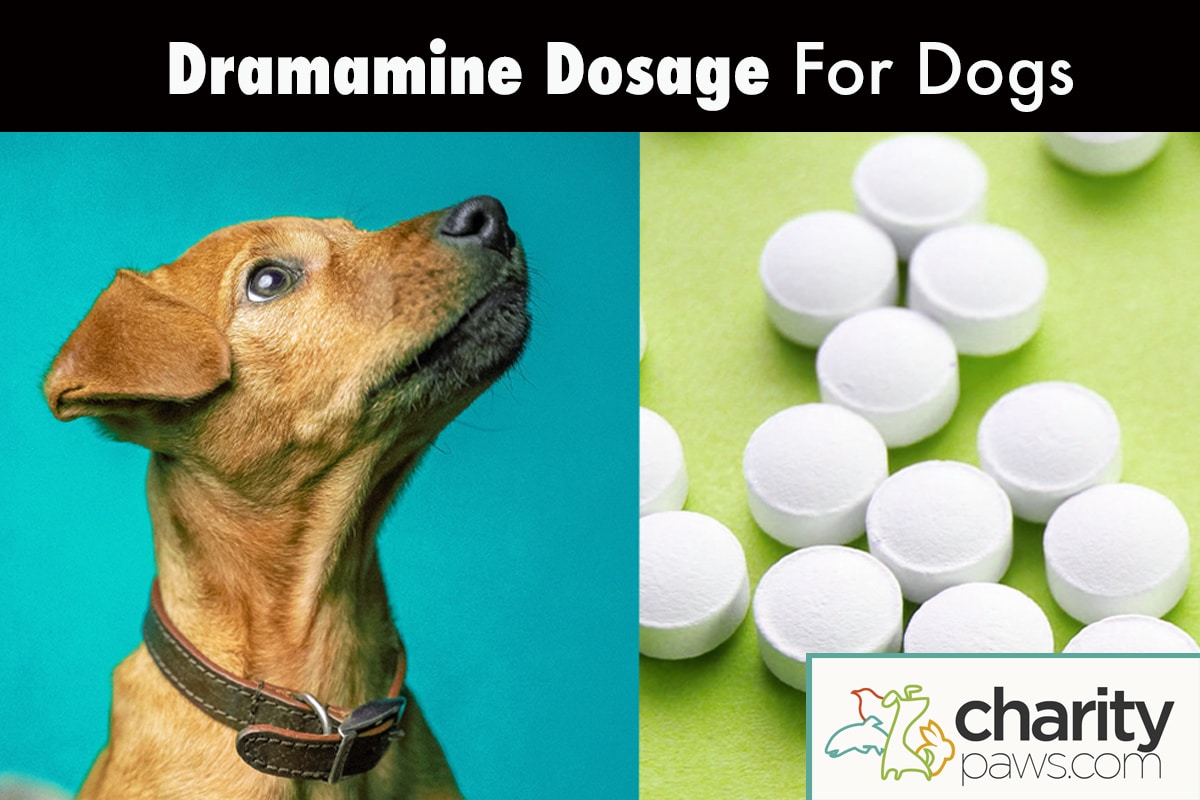It can be tempting to give your dog some of your own medication, especially if they seem nauseous.
Dramamine is a drug that many people keep at home, especially if you regularly suffer from motion sickness.
So what is the Dramamine dosage for dogs, or how much can you give them?
Is it safe to share this medication with our pets or not?
In this article, we will explore Dramamine in more detail and motion sickness in dogs, as well as some practical steps you can take to help your pet.
What Is Dramamine Used For?

Dramamine is a human medication used by people who suffer from motion sickness or nausea.
Dramamine is actually a brand name, the generic drug it contains is called dimenhydrinate.
Dimenhydrinate is a first-generation antihistamine, whose exact mechanism is unclear, but it is thought to act by blocking histamine receptors and adenosine receptors.
It is available as an over-the-counter medication. This drug is not licensed for use in dogs, however.
Motion Sickness Symptoms In Dogs
We know that dogs can suffer from motion sickness just as people do.
It seems to most commonly affect puppies and young dogs, with many growing out of it as they mature.
Signs of motion sickness include:
- Vomiting
- Drooling
- Licking lips excessively
- Appearing anxious or unsettled
- Trembling
- Heavy breathing
- Whining or crying
- Excessive yawning
- A negative association to the car (unwilling to get in the vehicle, etc)
Some dogs may vomit soon after starting a journey, whereas others may show symptoms of nausea for extended periods.
This can lead to unpleasant feelings of anxiety, and a negative association with traveling.
Is Dramamine Safe For Dogs?
Dramamine is not licensed for use in dogs and therefore it has not undergone rigorous safety testing in dogs.
However, the active ingredient dimenhydrinate is thought to be relatively safe in dogs when given under veterinary supervision.
Your vet may prefer to prescribe a medication that is specifically licensed for use in dogs first though, such as maropitant, before resorting to extra-label alternatives.
How Much Dramamine Can I Give My Dog?

You should only ever give Dramamine if your veterinarian advises you to.
Consult your veterinarian before giving any dosage of Dramamine.
A usual dosage of Dramamine is 2-4 mg per pound of your dog’s weight. This should not be giving more than once every 8-hours.
They will recommend the dose based on your pet’s weight and health status.
It is important never to use human medication for your dog without the guidance of a vet.
They may also be able to suggest some more effective, licensed versions of anti-nausea medication to give your dog instead.
Are There Side Effects With Taking Dramamine?
As with any medication, there is the potential for side effects when using Dramamine.
The most common side effects seen in dogs are:
- Lethargy
- Sedation
- A dry mouth
- Urine retention (inability to empty the bladder fully)
- Vomiting and diarrhea
Dramamine should only ever be used under the guidance of your veterinarian.
Some health conditions may increase the risks associated with this medication.
Extra care will need to be taken in animals that suffer from blood pressure issues, liver and kidney problems, urinary issues, and in those that are pregnant or nursing.
Are There Alternative Methods To Stop Motion Sickness In Dogs?
There are plenty of other steps you can take to help your dog with his motion sickness.
Vomiting and nausea are usually associated with anxiety, so many of these alternative methods will help to target the negative feelings your dog might have about car journeys.
Positive Association Training
Many dogs will start to build a negative association with the car if they associate it with feeling unwell.
They may start to resent getting in or could feel anxious about the journey ahead if they are worried about being sick.
Start training your dog to feel more positive about the car ride to help counteract this.
Start by letting them sniff around and explore the car at their own pace.
Let them jump in the car or the trunk if they want to.
Once in the car reward them with a treat, toy, or some fuss.
Just allow your dog to sit in the car while it is parked.
Once they are comfortable with this, turn the engine on for a short while keeping the vehicle stationary. Again, reward your dog.
Next take a very short journey in the car, even just a quick trip around the block.
If they are happy with this, then start short journeys, ideally ending up at nice locations such as a favorite walk or the park.
Hopefully, over time you can extend these journeys and start taking trips to the beach or lakes with your dog.
If the only time your dog ever goes in the car is to somewhere they do not like (such as the vet), they will form a negative association with it.
This negative association will be reinforced if they feel sick each time they go.
Hopefully by visiting lots of nice places, and keeping journeys short to begin, you can help your dog to feel less anxious about traveling.
Crate Training
Crate training can be helpful for some dogs.
Crates can feel like a cozy den for dogs, a place of security and comfort.
Not only that but traveling in a crate is far safer than traveling loose in the car.
You must crate train your dog properly though, to help him accept it.
You can start by encouraging your dog to use the crate in the house.
Make sure the door is open and will not swing shut on your dog accidentally.
Feed him his meals in there and put his favorite toys and treats inside so that he associates the crate with positive things.
After a while, gradually introduce door closing for short periods, letting your dog out right away if he shows any signs of distress.
Build up the time he is happy to spend in there.
Crates should always be positive places and never be used as punishment.
Ensure the crate is comfortable and your pet has enough room to sit, stand up, and stretch out in it.
The crate can be used as a bed area in the house for your pet, as well as a safe and familiar place in which to travel on car journeys.
Avoid Large Meals Before Traveling
Avoid feeding large meals or copious amounts of treats just before a car journey.
Some dogs may feel nauseated on a completely empty stomach, so try a very light meal of bland easy to digest food at least a couple of hours before you set off.
Also, make sure your dog has had the chance to go to the bathroom and stretch his legs before the journey.
Short Journeys Or Take Regular Breaks
If your dog suffers from motion sickness, then sticking to short journeys where possible is advised.
If you have to go on a long journey, then try and break things up by stopping regularly to let your dog stretch his legs and put his paws on firm ground for a while.
It also allows your dog the chance to go to the bathroom and have a drink.
Aim to have a break at least every 1.5-2 hours, even if your dog isn’t making a fuss to stop.
Pheromones
The use of appeasing pheromones can help calm some anxious dogs, which in turn may help with their nausea.
These pheromones mimic the ones given off by mother dogs around their puppies, so it can have a very natural feel-good effect on our canine companions.
Different formulations are available, but when used for car journeys a collar impregnated with pheromones or a spray for the bedding they are traveling with will be more helpful than plug-in diffusers, which are usually used in the home.
Supplements For Anxiety
There are many different supplements available to help with anxiety in dogs which could help make for a more relaxed car journey.
Nutritional supplements are usually available to purchase without a prescription, but as such you might find they are not quite as effective as some drugs your vet might be able to prescribe.
However, for some dogs, these can help take the edge off of symptoms, in conjunction with some of the previously mentioned behavioral training.
Conclusion
Dramamine is a human medication and must only ever be used in dogs under the guidance of your veterinarian.
However, be prepared that your vet may wish to prescribe alternative licensed drugs before exploring human alternatives such as this.
If your dog suffers from motions sickness, then it is always worth looking at some behavioral training as well as directly treating nausea.
By reducing any feelings of anxiety associated with the car you can hopefully help your dog to relax, which should in turn help reduce feelings of motion sickness.
FAQs
Will Dramamine make my dog sleep?
One of the known side effects of the active ingredient dimenhydrinate in people is drowsiness, so the same could occur in dogs.
This could help make him feel more settled for a car journey but be aware that in some cases dogs could become very sedated particularly if they have overdosed on the drug.
How long does Dramamine take to work?
It is recommended that Dramamine should be taken 30-60 minutes before the anticipated travel.
So, it should start working during this time.
Do not wait until your pet feels sick before administering his anti-nausea medication, always follow your veterinarian’s instructions.
What is the dosage of Dramamine for dogs?
If your veterinarian has given you the okay to give this motion sickness drug to your dog, they will usually recommend 2-4 mg per pound of body weight.
Your veterinarian will tell you exactly how much to give and how often. Usually a dose is given once every 8 hours.

